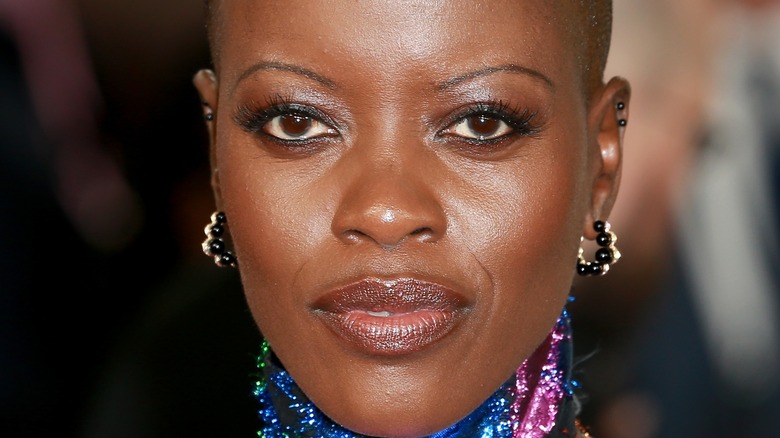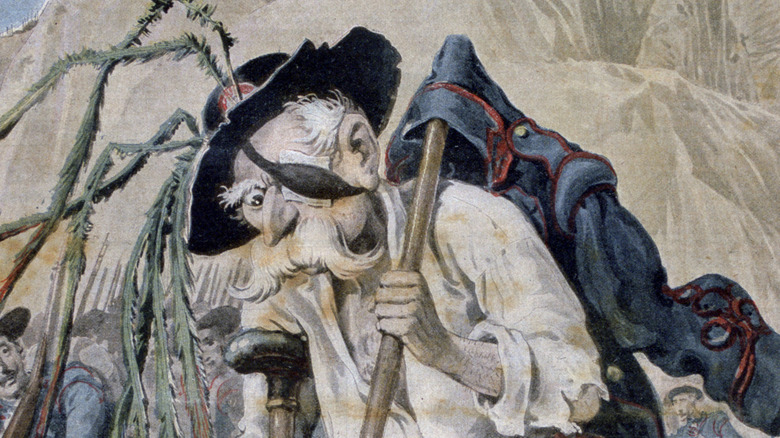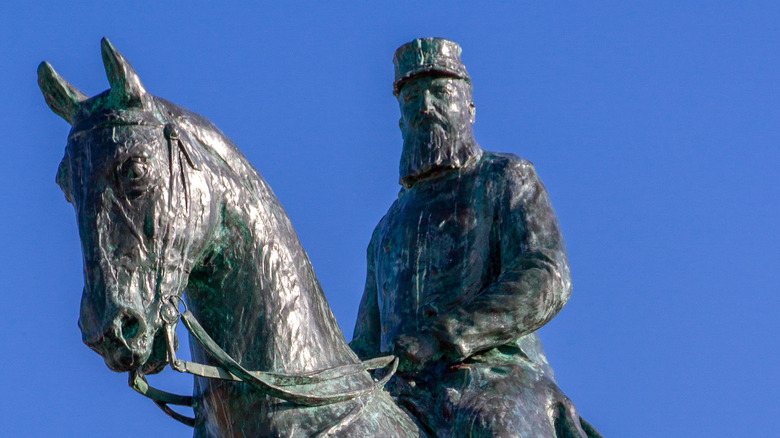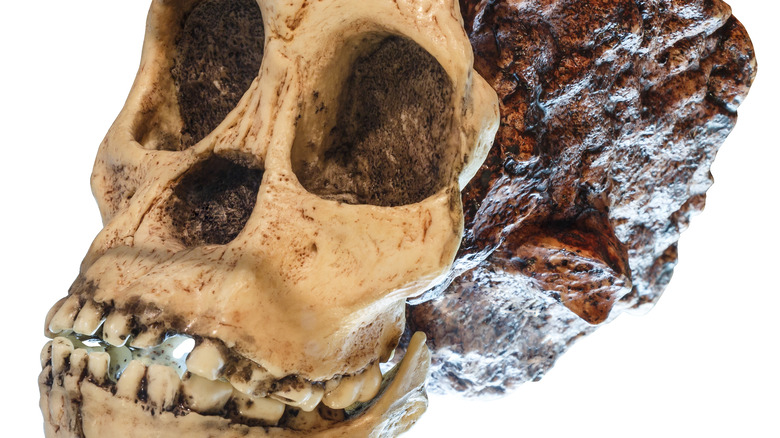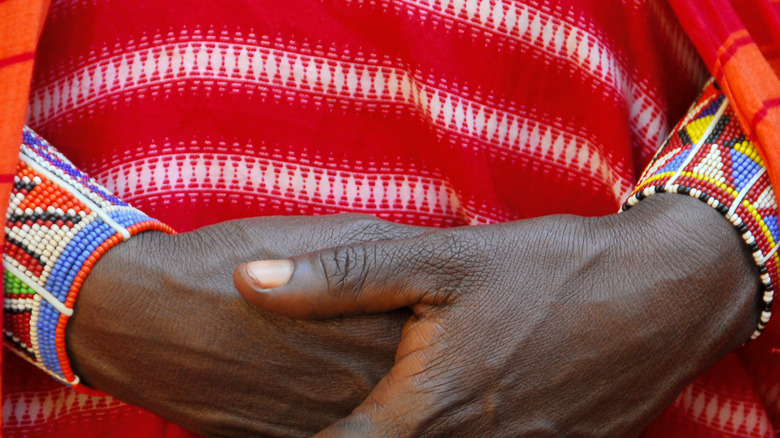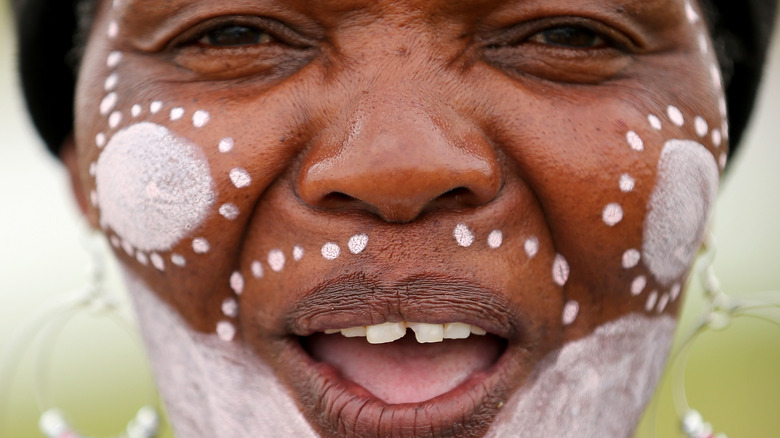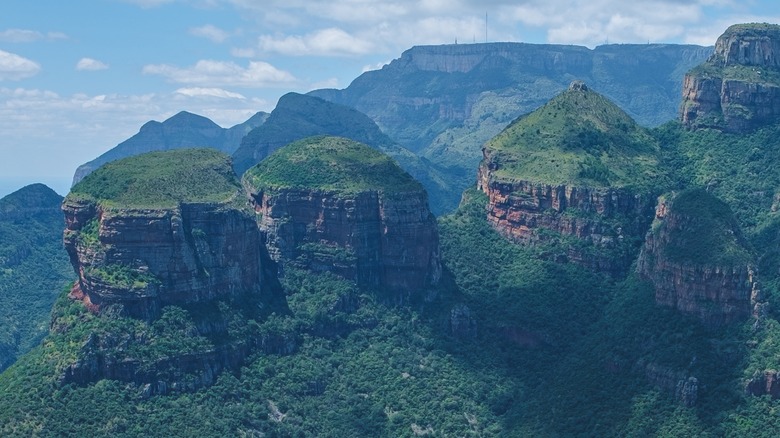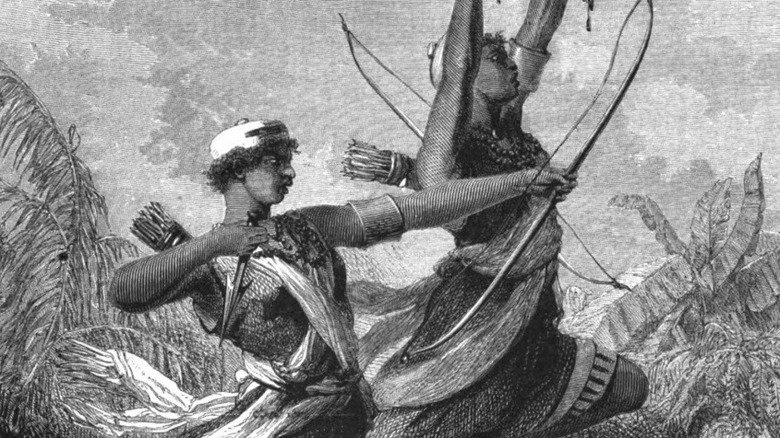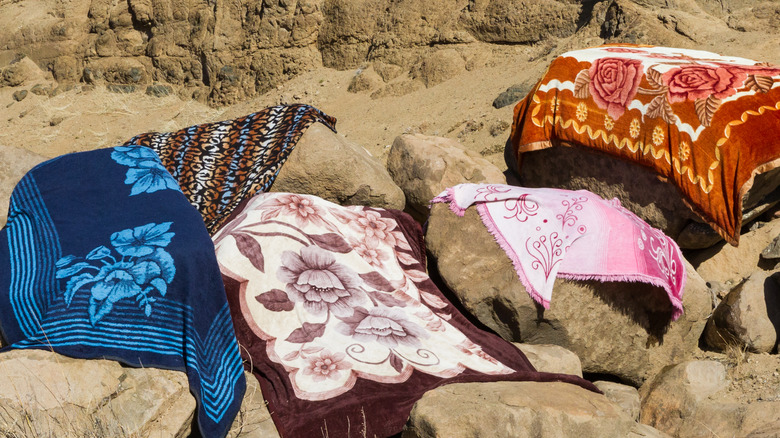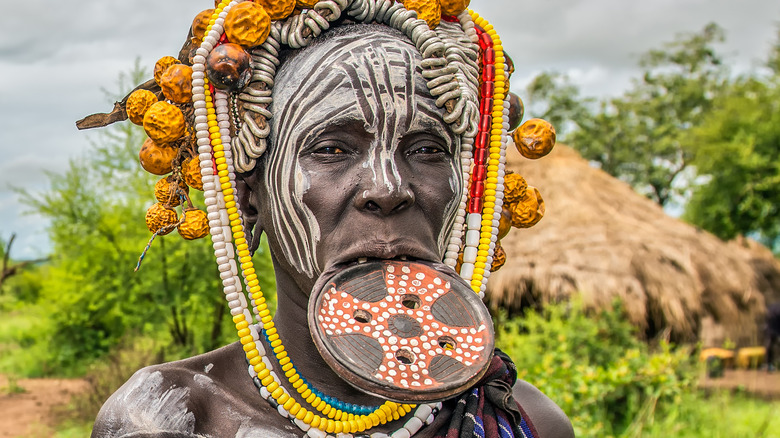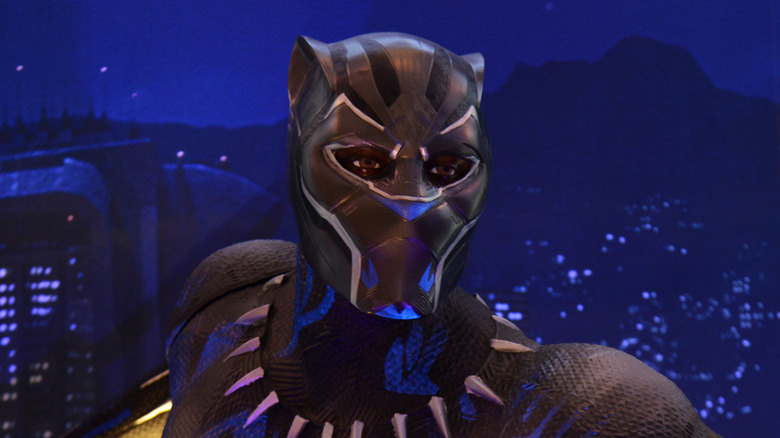Black Panther: The Real-Life Inspirations For Wakanda
The kingdom of Wakanda, the fictitious location of the Marvel smash-hit "Black Panther," draws on many different aspects from its real-life neighbors across Africa, from their history, politics, fashion, and architecture. Part of the reason for the film's immense success was that it refreshingly depicted an African country that was not beset by war, poverty, and famine. "Black Panther" doesn't swerve away from the harsh realities that Wakanda attempts to keep at bay, from the strings-attached nature of foreign aid and crushing debt, to the attempts at resource and artifacts theft at the hands of opportunistic westerners. Instead, it deals with them by showing the innovation, dynamism, and sense of justice that defines the rule of King T'Challa – a man who may have inherited his title, but more than proves his worth in the comics as well as the films (via Ohio State University).
It's true that one of the few Hollywood films to give a rounded view of an African country is based on a fantasy – yet The New Yorker points out that it's no less unreal than the popular — and more damaging — view of Africa as purely violent and chaotic. Furthermore, "Black Panther" leans heavily on real life and engages with themes that are ever-present in the world we live in. Like the best superhero films, it holds a mirror up to the present, inviting us to revel in the breadth and depth of architecture, engineering, geography, history, and fashion that can be found across the continent. Just some of them are explored here.
Ethiopia and Liberia - avoiding imperialism
Wakanda is just one country, but presents an "Afrofuturist" vision of what an entire continent might have looked like had history gone in a different direction. In the counterfactual world of Marvel, Wakanda is presented as the only African country to have avoided becoming virtual serfs at the hands of marauding Europeans with firepower, as pointed out by Dwayne Wong for HuffPost. In the process, the makers of "Black Panther" drew on the histories of Ethiopia and Liberia, considered the only two countries to avoid colonization.
Ethiopia was attacked by Italian forces at the Battle of Adwa in 1896, an offensive that became legendary in national memory due to the Italians' defeat. The biggest formal carve-up of the continent between the major European powers had happened only 12 years before, in 1884 (via History). Ethiopia's blow for self-determination was to have global resonance for decades to come. Although the Italians made another attempt at colonization under the dictator Mussolini, it only lasted from 1936 to 1941 (via the Imperial War Museum).
Liberia was founded as a destination for free American Black people, and although a colony, it gained independence from the US over 100 years before those under European rule, as the Office of the Historian explains. However, as Wong points out, every African country has been impacted by imperialism in some way, perhaps shown by the film's depiction of those who try to penetrate Wakanda and undermine the main source of its power — vibranium.
Congo - abundant resources
The mineral behind Wakanda's wealth and power is vibranium, an alien substance sitting in the nation due to a meteorite crash. Vibranium is a highly-desirable mineral that leads Wakandan scientists to develop a whole range of revolutionary technologies — and its capacity for weaponry means it is highly sought-after by scientists who have gauged at what lies beneath the veil in this deceptively poor nation, as descrived by Ohio State University (OSU).
There are painful historical resonances with this fictional narrative. The resource abundance of countries like the Democratic Republic of Congo, which should have become as wealthy as Norway or Sweden, strongly influenced "Black Panther." In real life, this part of Africa saw minerals like cobalt and uranium frittered away by foreign powers, while life for many was nasty, brutish, and short. King Leopold II of Belgium used it as a private slaving ranch, where conditions for the Africans who worked it were so horrific they inspired the Joseph Conrad novel "Heart of Darkness" (via St John's College, Cambridge).
Uranium was a major influence on how Wakanda was conceived. Published in the late 1960s, OSU shows how "Black Panther" came into a world where uranium was being mined to develop nuclear weapons, as it already had been for the bomb dropped on Hiroshima. A violent struggle took place in the 1960s about who had the right to it, and Wakandans share a similar concern about vibranium: They know the consequences could be disastrous if it fell into the wrong hands. Despite its prosperity, Wakanda can't escape the fear of it being stolen.
Africa as the birthplace of humanity
The producer of "Black Panther," Nate Moore, has said to Nerdist that in the Marvel Cinematic Universe, Wakanda is the place where some of the first Africans came from, spreading out, influencing, and blending with other cultures that evolved over time. Moore stated that the reason Wakanda has a lot of shared traits with other African countries, despite being a very insular state, is because it was expansionist: Wakandans took their styles, traditions, and beliefs with them, in turn spawning the evolution of many other countries on the continent.
It's a bit of backstory which echoes a belief among archaeologists that the first humans originated from Africa. Smithsonian describes how the discovery of a child fossil in 1924, the "Taung Child," in South Africa led to the burgeoning theory that the remains showed a link between apes and humans. Although it wasn't universally believed, the discovery by anatomist Raymond Dart led to a revolution in scientific approaches to the human story.
Other paleontologists found "ape-man" fossils in South Africa in the 1940s and 1950s, leading more members of the scientific community to believe Dart's theory that the first humans to evolve from apes had come from Africa — a species he named "Australopithecus Africans." Prior to this — and for a large part of the 20th century — archaeologists believed humans had come from Europe or Asia. The result of these new discoveries was that more people started looking for fossils in Africa, believing conclusive proof about where humans originated lay just beneath the surface.
Ndebele, Maasai and Zulu fashions
The fashion choices in Wakanda are directly influenced by the distinctive kinds of clothing worn in parts of east and southern Africa. According to Skratch, the headpiece worn by King T'Challa's mother, Ramonda, draws heavily on the circular headgear made and worn by women of Zulu origin (a group largely based in South Africa). Although the white circular hat worn by Ramonda when she greets her returning son was made using three-dimensional printing techniques, it was based on headwear normally crafted by hand from cotton and grass. In real life, these hats are worn for major life events such as weddings.
In an interview with Yahoo Entertainment, the members of Wakanda's women-only protection units, the Dora Milaje, wear a highly stylized red uniform adorned with vibranium bracelets and neck rings, heavily drawing on gear pioneered by Ndebele women (from the northeastern regions of South Africa). To give them a sense of strength and authority, they carry spears like those brandished by Maasai warriors (a nomadic group from Kenya, where male fighters used to see lion-killing as a right of passage, via The Washington Post). Their metal bangles and red clothes are also worn by Maasai women, with red having long been used as a color to scare off lions (via Adumu Safaris).
The Maasai are known for making most of their jewelry by hand. "Black Panther" costume designer Ruth Carter was inspired by this, saying she wanted the bespoke vibranium body gear to seem like it had been specially hammered and forged for these warriors.
Xhosa and Zulu - languages of clicks
Entertainment Weekly draws attention to how, since Wakanda escaped colonialism, the country would not have been forced to adopt a European language such as English — yet this is never addressed in the comics. In the film "Black Panther," when King T'Challa is communicating with friends and relatives, he speaks in a language that draws heavily on clicking and popping noises made by the tongue, an iconic feature of the Xhosa and Zulu languages. Joe Russo, director of previous Marvel films, stated that Xhosa was a particular inspiration for the main language in Wakanda, given that around 6.4 million people speak it. For many westerners, Nelson Mandela was the most high-profile Xhosa speaker.
The Week highlights several theories around how click sounds developed. While Khoisan languages have always had clicks, the Niger-Congo languages (of which the Xhosa and Zulu are a part) only incorporated them in the last few centuries. Linguist Robert Herbert posited in the 1990s that people used sounds to avoid saying words out of respect, particularly the names of rulers, or to imply trouble, such as when referring to dangerous animals.
The more that clicks were used, the more they made words sound polite instead of just replacing them. This led the click sounds to spread, to the point where clicks are now present in about 15% of Zulu and Xhosa words. For the Khoisan languages, the number of click-words is higher, at 40%, probably because they were sheltered from other linguistic influences, thus stopping the clicks from being pushed out.
Wakanda as modern-day Mutapa
The jury is still out on which one country inspired Wakanda, with the comics implying strongly that Congo and Ethiopia were both major inspirations. Yet for the "Black Panther” film, the late actor Chadwick Boseman, who played the titular superhero and king of Wakanda, said to The New York Times that it was based on Mutapa, an early-modern empire that sprawled out between what is now Zimbabwe, South Africa, Zambia, and Mozambique. According to Edward Mabaya, the associate director of Cornell's Institute for Food, Agriculture and Diplomacy (via NPR), it became a major 15th-century global trading power, basing its wealth not on plundering and pillaging in foreign wars. This was unusual, as many southern African kingdoms in this period were notable for their military prowess.
This is reflected in Wakanda's desire to build itself up through technological innovation rather than warfare and conquest. Furthermore, Wakanda's secretive possession of vibranium echoes the gold, salt, cotton, and ivory reserves that were key to Mutapa's reserves of wealth. The 15th-century kingdom meted out heavy punishments to anyone who revealed the location of the gold mines, with anyone who did so being executed. This differs slightly from Wakanda, which eventually decided to offer the secrets of vibranium to the wider world.
Wakanda's approach to urban planning also seems to have mimicked Mutapa's. Local chiefs oversaw the governance of small villages, which in turn were subordinate to provinces answering to the governing body in the capital, headed by a king (or "Munhumutapa") believed to be in his position by divine mandate.
South African and Malian architecture
Production designer Hannah Beachler was heavily influenced by hut-shaped rondavels from South Africa when she imagined what buildings in Wakanda would look like. In an interview with Collider, she talks about traveling to Three Rondavels, a place within the Blyde River Canyon near the border between South Africa and Lesotho, where the rocks inspired the structure of people's roofs for many centuries. It segued into Beachler's desire to show Wakanda as a place that elegantly blended nature and history with the efficient and prosperous, utilizing the circular designs to absorb sound and vibration — a key aspect of vibranium technology.
Beachler's inspiration is peppered throughout "Black Panther," with spherical buildings and circular decor serving as the key visual indicators within the Great Mound, the City of the Dead, and the Throne Room in Wakanda. It's an open secret — when you see it once, you see it everywhere.
The iconic mud structures of Mali were another visual cue for Beachler. A mud pyramid sits in the Wakandan throne room, making for a sly contrast with all the sleek glass and steel that makes up the rest of the country's urban topography. Beachler claims this is because in the more calm and intimate moments of the film she wanted the space to be wider and softer. Old and new, sharp and soft — Wakanda is a place of harmonious contrasts, where the viewer is subtly introduced to thousands of years of structural tradition, all within the most technologically advanced place on earth.
The warrior women of Dahomey
The Kingdom of Dahomey in present-day Benin produced a legendary all-female fighting force, nicknamed "the Amazons" but known by some today as "mino," who inspired the women warriors depicted in Wakanda. The ferocious and highly loyal Dora Milaje, with their distinctive shaved heads and stark red body armor, take on various threats to Wakanda, both internal and external, overturning abiding stereotypes about the role of women in such spaces.
Yet they are part of a long trajectory. According to the BBC, the female soldiers of Dahomey were often in the line of fire during the battles fought by the kingdom, between the mid-17th and late-19th centuries. They shocked colonial soldiers with their fearlessness and military acumen, so much so that the moniker "the Amazons" was given to them as a comparison to the fighting force of ancient Greek myth and legend.
Their origins are unclear. Some historians have stated the women were originally elephant hunters who simply longed for bigger targets, while others claim it is more likely they were bodyguards for Hangbe, the enigmatic queen of Dahomey whom legend says took the throne after the death of her twin brother. Whether or not Hangbe was real is also contested, but the female guards are still thought to have served the later kings of Dahomey. Ultimately, the kingdom was not able to keep colonialism at bay, and it became part of the French empire. Yet the women were not forgotten: People who claim to be their descendants are still venerated and respected today.
Lesotho - fashion and topography
The tiny country of Lesotho resides within South Africa and managed to avoid much of the colonial excesses that befell its larger cousin. Skratch details how the makers of "Black Panther" found creative stimulation when visiting the landscapes within Lesotho, whose mountainous borders are reflected in the more rural areas of Wakanda. In "Black Panther," guards posing as low-key farmers patrol the opaque space between Wakanda and the world outside, which this furtive African nation is keen to keep at bay (via Quartz).
These characters are seen wearing blue and green Basotho blankets as cloaks, which act as protective force fields. Aside from their magical properties, the blankets have major cultural significance, often being draped around people of exalted status in the community. The Blanket Wrap (via Maliba Lodge) details how costume designer Ruth Carter studied patterns from the Basotho people, selecting which ones to use in "Black Panther," and thereby continuing the process of blending indigenous garb with fantastical technologies. As with much of the world-building in "Black Panther," the idea was to show what African ideas and styles could organically become with colonialism.
The film team got permission from blanket-makers in Lesotho to use their designs, ensuring that the money from any items purchased fed back into the local economy. Cultural appropriation and the theft of meaningful national symbols — which have a long history in Africa — were therefore avoided. Carter stressed that she was keen to avoid stereotyping, not wishing to steal African symbols purely to benefit Hollywood and promote generalized ideas about an African nation.
Namibia and the Ethiopian Mursi peoples - red-tinted skin and lip discs
Other distinctive fashion choices in Wakanda include the practice of stretching lower lips with plates, practiced by the Mursi peoples of Ethiopia, and the red skin mixture used as a beauty treatment by people in Namibia.
Lip discs appear in "Black Panther" among members of one of the country's major governing bodies, which brings together representatives from Wakanda's various ethnic groups, as highlighted by Skratch. Among the Mursi peoples of southwestern Ethiopia, adolescent women (not men, as the film implies) have their lips slit just slightly by an older female relative. A wooden plug is placed in, and when it heals and widens, a disc is used to stretch the lip as far as 12cm. It is a distinctive and recognizable phenomenon with a long history, although it has also been criticized as an unnecessary and agonizing practice, one only kept going to appease western tourists. That said, the Mursi Online resource from Durham University states that women in Mursi communities are rarely forced into the practice by their elders or their peers, and it is seen as a matter of individual choice.
Council members in Wakanda are also shown wearing red Otjize paste on their hair and skin, a style pioneered by the Himba people of Namibia. The Guardian in Nigeria highlights how the mixture is made from clay, sand, and ferric oxide, which when combined makes a red ochre to be mixed with butter, woven into hair, and spread over skin.
Wakandan linguistics - Nsibidi symbols
Symbols from Wakanda's lingua franca are shown in scenes where King T'Challa sits in his throne room. The language is a fusion of the ancient hieroglyphic Nsidi scripts from the Igbo people — who lived in what is now modern-day Nigeria – and Latin-based Roman numerals. Although when spoken it sounds like Xhosa, as explored above, the written version is based on something quite different, and altogether unique.
Indiewire details how Hannah Beachler, the production designer for "Black Panther," wanted to create a whole new language for Wakanda. As well as fourth-century Nsidi symbology and Roman numerals, she drew inspiration from local graffiti art found in the South African mountains, as well as graffiti found in the streets of LA. She then combined various lines and dots with the scripts of a range of languages, including Dogon and Mursi from Africa, as well as Mandarin and Arabic.
The result was a highly sophisticated and original range of symbols, one version of which was painted onto the pillars of the throne room for the Wakandan royal family, while other local variants can be found throughout the room, with slightly different ones for each ethnic group. Both secretive and advanced, Beachler designed the language to fit seamlessly within the world-building of the film. Although fictitious, it gives the appearance of having gone through the syncretic processes common to many languages across the globe. In short, it is the essence of Afrofuturism: paying tribute to the past while depicting a freer, less oppressed African society, full of optimism and hope.
